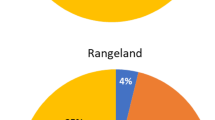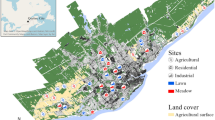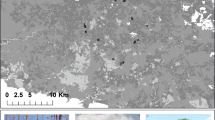Abstract
Agricultural intensification leads to large-scale loss of habitats offering food and nesting sites for bees. This has resulted in a severe decline of wild bee diversity and abundance during the past decades. There is an urgent need for cost-effective conservation measures to mitigate this decline. We analysed the impact of five different high-quality habitats on species richness and abundance of wild bees in a complex landscape of north-western Switzerland at six sites. The five habitat types included 45 plots situated on eight organic farms and were composed of 16 low-input meadows, six low-input pastures, seven herbaceous strips adjacent to hedges, five sown flower strips and eleven organic cereal fields. All of them are financially subsidised by the Swiss agri-environmental scheme. Wild bees were sampled between the end of April and end of August 2014 by using trio-pan traps and complementary sweep netting on these five habitat types. On 45 plots we recorded 3973 bee specimens, belonging to 91 species, 16 of which are red listed, revealing a high bee species richness in the study area. Wild bee species richness and abundance were best explained by habitat type, number of flowering plants and site. A strong relationship of increasing number of flowering plants and bee species richness and abundance was found. Grassland habitats, especially low-input meadows, harboured the highest species richness and abundances. Organic cereal fields showed a potential to conserve bee species relevant to nature conservation (harbouring exclusively two red list species and four rare species). Ordination analysis of the bee communities showed a relative dissimilarity between the habitat types and indicates their complementary effects to benefit the diversity of wild bees. Our results demonstrate that a matrix of low-input habitats are needed to sustain rich assemblages of wild bees in agroecosystems.



Similar content being viewed by others
References
Amiet F (1994) Rote Listen der gefährdeten Tierarten in der Schweiz. Edt P Duelli, pp 38–44 BUWAL
Aviron S, Nitsch H, Jeanneret P, Buholzer S, Luka H, Pfiffner L, Pozzi S, Schüpbach B, Walter T, Herzog F (2009) Ecological cross compliance promotes farmland biodiversity in Switzerland. Front Ecol Environ 7:247–252
Bates D, Maechler M, Bolker B, Walker S (2014) lme4: linear mixed-effects models using Eigen and S4. R package version 1.1-7. http://CRAN.R-project.org/package=lme4
Biesmeijer JC, Roberts SP, Reemer M, Ohlemuller R, Edwards M, Peeters T, Schaffers AP, Potts SG, Kleukers R, Thomas CD, Settele J, Kunin WE (2006) Parallel declines in pollinators and insect-pollinated plants in Britain and the Netherlands. Science 313:351–354
Borcard D, Gillet F, Legendre P (2011) Numerical ecology with R. Springer, New York, p 306
Burkle LA, Marlin JC, Knight TM (2013) Plant-pollinator interactions over 120 years: loss of species, co-occurrence, and function. Science 339:1611–1615
Carrié R, Andrieu E, Cunningham SA, Lentini PE, Loreau M, Ouin A (2017) Relationships among ecological traits of wild bee communities along gradients of habitat amount and fragmentation. Ecography 40(1):85–97
Clough YA, Holzschuh A, Gabriel D, Purtauf T, Kleijn D, Kruess A, Deweter IS, Tscharntke T (2007) Alpha and beta diversity of arthropods and plans in organically and conventionally managed wheat fields. J Appl Ecol 44:804–812
Clough Y, Ekroos J, Báldi A, Batáry P, Bommarco R, Gross N, Holzschuh A, Hopfenmüller S, Knop E, Kuussaari M (2014) Density of insect-pollinated grassland plants decreases with increasing surrounding land-use intensity. Ecol Lett 17:1168–1177
De Palma A, Kuhlmann M, Roberts SP, Potts SG, Börger L, Hudson LN, Purvis A (2015) Ecological traits affect the sensitivity of bees to land-use pressures in European agricultural landscapes. J Appl Ecol 52(6):1567–1577
Forrest JRK, Thorp RW, Kremen C, Williams NM (2015) Contrasting patterns in species and functional-trait diversity of bees in an agricultural landscape. J Appl Ecol 52:706–715
Garibaldi LA, Steffan-Dewenter I, Kremen D, Morales JM, Bommarco R, Cunningham SA, Carvalheiro LG, Chacoff NP, Dudenhoeffer JH, Greenleaf SS (2011) Stability of pollination services decreases with isolation from natural areas despite honey bee visits. Ecol Lett 14:1062–1072
Garibaldi LA, Carvalheiro LG, Leonhardt SD, Aizen MA, Blaauw BR, Isaacs R. Kuhlmann M, Kleijn M, Klein AM, Kremen C, Morandin L, Scheper J, Winfree R (2014) From research to action: enhancing crop yield through wild pollinators. Front Ecol Environ 12:439–447
Gathmann A, Tscharntke T (2002) Foraging ranges of solitary bees. J Anim Ecol 71(5):757–764
Gelman A, Su Y (2014) Arm: data analysis using regression and multilevel/hierarchical models R package version 17-03 2014. Cambridge University Press, New York
Gill RJ, Ramos-Rodriguez O, Raine NE (2012) Combined pesticide exposure severly affects individual- and colony-level traits in bees. Nature 491:105–109
Giraudoux P (2014) pgirmess: Data analysis in ecology. https://cran.r-project.org/web/packages/pgirmess/index.html
Goulson D, Nicholls E, Botías C, Rotheray EL (2015) Bee declines driven by combined stress from parasites, pesticides, and lack of flowers. Science 347:1255957
Holzschuh A, Steffan-Dewenter I, Kleijn D, Tscharntke T (2007) Diversity of flower-visiting bees in cereal fields: effects of farming system, landscape composition and regional context. J Appl Ecol 44:41–49
Holzschuh A, Steffan-Dewenter I, Tscharntke T (2008) Agricultural landscapes with organic crop support higher pollinator diversity. Oikos 117:354–361
Hothorn T, Bretz F, Heiberger RM, Schuetzmeister A (2015) multcomp: Simultaneous inference in general parametric model. https://cran.r-project.org/web/packages/multcomp/index.html
Jönsson AM, Ekroos J, Dänhardt J, Andersson GKS, Olsson O, Smith HG (2015) Sown flower strips in southern Sweden increase abundances of wild bees and hoverflies in the wider landscape. Biol Conserv 184:51–58
Kleijn AM, Vaissiere BE, Cane JH, Steffan-Dewenter I, Cunningham SA, Kremen C, Tscharntke T (2007) Importance of pollinators in changing landscapes for world crops. Proc R Soc B 274:303–313
Knight ME, Osborne JL, Sanderson RA, Hale RJ, Martin AP, Goulson D (2009) Bumblebee nest density and the scale of available forage in arable landscapes. Insect Conserv Divers 2:116–124
Kovács-Hostyánszki A, Espíndola A, Vanbergen AJ, Settele J, Kremen C, Dicks LV (2017) Ecological intensification to mitigate impacts of conventional intensive land use on pollinators and pollination. Ecol Lett 20:673–689
Kremen C, Gonigle LKM (2015) Small-scale restoration in intensive agricultural landscapes supports more specialized and less mobile pollinator species. J Appl Ecol 52(3):602–610
Le Féon V, Burel F, Chifflet R, Henry M, Ricroch A, Vaissière BE, Baudry J (2013) Solitary bee abundance and species richness in dynamic agricultural landscapes. Agric Ecosyst Environ 166:94–101
Michener CD (2007) The bees of the world, 2nd edn. The Johns Hopkins University Press, Baltimore
Müller A, Diener S, Schnyder S, Stutz K, Sedivy C, Dorn S (2006) Quantitative pollen requirements of solitary bees: implications for bee conservation and the evolution of bee-flower relationships. Biol Conserv 130:604–615
Oertli S, Müller A, Dorn S (2005) Ecological and seasonal patterns of diversity in a species-rich bee assemblage (Hymenoptera: Apoidea: Apiformes). Eur J Entomol 102:53–63
Pe’er G, Dicks LV, Visconti P, Arlettaz R, Báldi A, Benton TG, Collins S, Dieterich M, Gregory RD, Hartig F, Henle K, Hobson PR, Kleijn D, Neumann RK, Robijns T, Schmidt J, Shawartz A, Sutherland WJ, Turbé A, Wulf F, Scott AV (2014) EU agricultural reform fails on biodiversity. Science 344:1090–1092
Potts SG, Vulliamy B, Dafni A, Ne´man G, Willmer P (2003) Linking bees and flowers: how do floral communities structure pollinator communities? Ecology 84(10):2628–2642
Potts SG, Biesmeijer JC, Kremen C, Neumann P, Schweiger O, Kunin WE (2010) Global pollinator declines: trends, impacts and drivers. Trends Ecol Evol 25:345–353
Power EF, Stout JC (2011) Organic dairy farming: impacts on insect-flower interaction networks and pollination. J Appl Ecol 48:561–569
R Development Core Team (2014) R: A language and environment for statistical computing. R Foundationfor Statistical Computing, Vienna
Rader R, Bartomeus I, Tylianakis JM, Laliberté E (2014) The winners and losers of land use intensification: pollinator community disassembly is non-random and alters functional diversity. Div Distrib 20:908–917
Roulston TH, Goodell K (2011) The role of resources and risks in regulating wild bee populations. Ann Rev Entomol 56:293–312
Sardiñas HS, Kremen C (2014) Evaluating nesting microhabitat for ground-nesting bees using emergence traps. Basic Appl Ecol 15(2):161–168
Sardiñas HS, Kremen C (2015) Pollination services from field-scale agricultural diversification may be context-dependent. Agric Ecosyst Environ 207:17–25
Schwarz M, Gusenleitner F, Westrich P, Dathe HH (1996) Katalog der Bienen Österreich, Deutschlands und der Schweiz (Hymenoptera, Apidae) Entomofauna Supplement 8 p 398 Linz
Sokal RR, Rohlf FJ (1995) Biometry. WH Freeman, San Francisco CA
Steffan-Dewenter I, Tscharntke T (2001) Succession of bee communities on fallows. Ecography 24(1):83–93
Strohm E, Bordon-Hauser A (2003) Advantages and disadvantages of large colony size in a halictid bee: the queen’s perspective. Behav Ecol 14(4):546–553
Sutherland WJ (2006) Ecological census techniques: a handbook, 2nd edn. Cambridge University Press, Cambridge
Swiss Confederation (2010) Verordnung über die biologische Landwirtschaft und die Kennzeichnung biologisch produzierter Erzeugnisse und Lebensmittel (Bio-Verordnung)
Swiss Confederation (2013) Verordnung vom 23 Oktober 2013 über die Direktzahlungen an die Landwirtschaft Bundesrat Bern Switzerland
Westphal C, Bommarco R, Carré G, Lamborn E, Morison N, Petanidou T, Potts SG, Roberts SPM, Szentgyörgyi H, Tscheulin T (2008) Measuring bee diversity in different European habitats and biogeographical regions. Ecol Monogr 78:653–671
Westrich P (1990) Die Wildbienen Baden-Württembergs 2 Bände Suttgart: Eugen Ulmer Verlag
Whitehorn PR, O’Connor S, Wäckers FL, Goulson D (2012) Neonicotinoid pesticide reduces bumblebee colony growth and queen production. Science 336:351–352
Winfree R, Aguilar R, Vazquez DP, LeBuhn G, Aizen MA (2009) A meta-analysis of bees’ responses to anthropogenic disturbance. Ecology 90:2068–2076
Wood TJ, Holland JM, Goulson D (2016) Diet characterisation of solitary bees on farmland: dietary specialisation predicts rarity. Biodivers Conserv 25:2655–2671
Zurbuchen A, Müller A (2012) Wildbienenschutz – von der Wissenschaft zur Praxis Bristol-Stiftung Zürich Haupt-Verlag Bern
Zurbuchen A, Landert L, Klaiber J, Müller A, Hein S, Dorn S (2010) Maximum foraging ranges in solitary bees: only few individuals have the capability to cover long foraging distances. Biol Conserv 143(3):669–676
Zuur AF, Ieno EN, Walker NJ, Saveliev AA, Smith GM (2009) Mixed effects models and extensions in ecology with R. Springer, New York
Acknowledgements
We thank Dreiklang Foundation, Vontobel Foundation, Temperatio Foundation and Oekoenergie Fonds (IWB) for their financial support. We would like to thank Fabian Cahenzli for fruitful comments, Simon Moakes for improving the English style and all participating farmers for their support and access to their fields and two anonymous reviewers for their useful and constructive comments.
Author information
Authors and Affiliations
Corresponding author
Ethics declarations
Conflict of interest
The authors declare that they have no conflict of interest. The funders had no role in study design, data collection and analysis, decision to publish, or preparation of the manuscript.
Electronic supplementary material
Below is the link to the electronic supplementary material.
Rights and permissions
About this article
Cite this article
Pfiffner, L., Ostermaier, M., Stoeckli, S. et al. Wild bees respond complementarily to ‘high-quality’ perennial and annual habitats of organic farms in a complex landscape. J Insect Conserv 22, 551–562 (2018). https://doi.org/10.1007/s10841-018-0084-6
Received:
Accepted:
Published:
Issue Date:
DOI: https://doi.org/10.1007/s10841-018-0084-6




